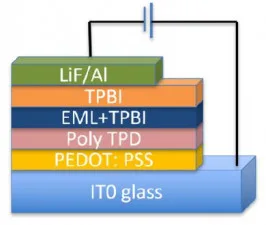A research team led by He Liu with the Materials Science and Engineering Program at Florida State University (Tallahassee, FL) is developing an effective approach to achieving efficient and stable blue light emission from LEDs based on metal halide perovskites.

A recent article on this topic by the team is entitled “Efficient and Stable Blue Light Emitting Diodes Based on CsPbBr3 Nanoplatelets with Surface Passivation by a Multifunctional Organic Sulfate.” The article was published in Advanced Energy Materials (2022). A copy of the article is available for purchase and can be found here.
Metal halide perovskites have several properties that make them attractive as a light emitting material. This includes not only the material’s excellent electro-optical properties but the facts that the associated LED device is easy and inexpensive to manufacture. The good news is that, at this time, highly efficient and stable LEDs have been created that can emit green and red light. Unfortunately, efficient and stable perovskite-based blue light emitting LEDs have not yet been achieved. wo of the reasons for this are that blue light emission requires a lot of power and that the purity of the blue color is often found to decrease over time. he lack of a suitable perovskite-based blue light emitter is significant because without it, the use of RGB to produce a white light emitting LED is not possible.
To address this issue, the team adopted an approach based on the use of nanoplatelets. Nanoplatelets are nanomaterials that have a thickness of only a few unit cells. Blue light emitting nanoplatelets were created by the researchers by using the metal halide perovskite chemical compound cesium lead bromide (CsPbBr3). To make these particular nanoplatelets emit efficient and stable blue light, the researchers coated them with a multifunctional organic sulfate having the abbreviated name EDBESO4. The EDBESO4 treatment led to surface passivation of CsPbBr3 nanoplatelets by both EDBE2+ and SO42– ions. This, in turn, helped to prevent the coalescence of nanoplatelets and suppressed the degradation of the nanoplatelets allowing them to emit a more efficient and stable blue light.
Utilizing the newly developed surfaced passivated CsPbBr3 nanoplatelets as emitters, prototype blue light emitting LEDs were fabricated. The figure below illustrates the structure of the prototype LED device. Structure of the prototype LED device.
The light emitted by the prototype LEDs peaked in the blue at 462 nanometers. The photoluminescence quantum efficiency was found to improve from ~28% for pristine CsPbBr3 nanoplatelets to ~85% for EDBESO4 treated CsPbBr3 nanoplatelets. The device had an external quantum efficiency of 1.77%, a luminance of 691 candela per square meter and a half life time of 20 minutes. The researchers represent these specifications as among the best values reported to date for a pure blue LED based on the use of perovskite and utilizing a nanoplatelet approach.
The researchers conclude their article with the statement that “Our work clearly shows the potential of using properly surface passivated perovskite nanoplatelets as emitters for highly efficient and stable LEDs.” -Arthur Berman
Florida State University, Biwu Ma, [email protected]

